Método de la Bisección#
Método gráfico#
a. $\(y = sen(x)\)\( b. \)\(y = x^3 - x\)\( c. \)\(y = sen(10x) + cos(3x)\)\( d. \)\(y = \frac{667,38}{x}(1 - e^{-0,146843x}) - 40\)$
import numpy as np
import math
import matplotlib.pyplot as plt
fig, axs = plt.subplots(1, 4, figsize=(20, 6))
x = np.linspace(-4*np.pi, 4*np.pi, 720)
y = np.sin(x)
axs[0].plot(x,y,color='blue',label="sen(x)")
axs[0].set(xlabel='X', ylabel='Y')
axs[0].grid()
axs[0].legend()
axs[0].set(xlim=(-4*np.pi, 4*np.pi),ylim=(-1.1, 1.1))
y=x**3-x
axs[1].plot(x,y,color='red',label="x^3 - x")
axs[1].set(xlabel='X', ylabel='Y')
axs[1].grid()
axs[1].legend()
axs[1].set(xlim=(-2.5, 2.5), ylim=(-2.5, 2.5))
y= np.sin(10*x)+np.cos(3*x)
axs[2].plot(x,y,color='black',label="sen(10x) + cos(3x)")
axs[2].set(xlabel='X', ylabel='Y')
axs[2].grid()
axs[2].legend()
axs[2].set(xlim=(-5, 5), ylim=(-2, 2))
x = np.linspace(-20, 40, 720)
y= ((667.38)/x)*(1-math.e**(-0.146843*x))-40
axs[3].plot(x,y,color='black',label="(667,38/x)(1 - e^(-0,146843x)) - 40")
axs[3].set(xlabel='X', ylabel='Y')
axs[3].grid()
axs[3].legend()
axs[3].set(xlim=(-20, 40))
plt.show()

Método de la Bisección#
# @title Método de bisección
import numpy as np
import matplotlib.pyplot as plt
plt.figure()
x = np.linspace(-0.8,0.8, 100)
y = x**3-x
fig, ax = plt.subplots()
ax.plot(x,y,color='blue',label="$X^3 - X$")
ax.grid()
## Plano cartesiano (Ejes)
ax.vlines(x=0,ymin=min(y),ymax=max(y),color='k')
ax.hlines(y=0,xmin=min(x),xmax=max(x),color='k')
## límites xl y xu
ax.vlines(x=0.6, ymin=0, ymax=min(y), color='k', linestyle='--')
ax.vlines(x=-0.6, ymin=0, ymax=max(y), color='k', linestyle='--')
# Agregar texto en una ubicación específica
text_x = 0.6 # Posición en el eje X
text_y = 0 # Posición en el eje Y
ax.text(text_x, text_y+0.01, 'xu', fontsize=12, color='black')
ax.text(-text_x, -1*(text_y+0.03), 'xl', fontsize=12, color='black')
ax.set_title("$X^3-X$")
plt.legend()
plt.show()
<Figure size 640x480 with 0 Axes>
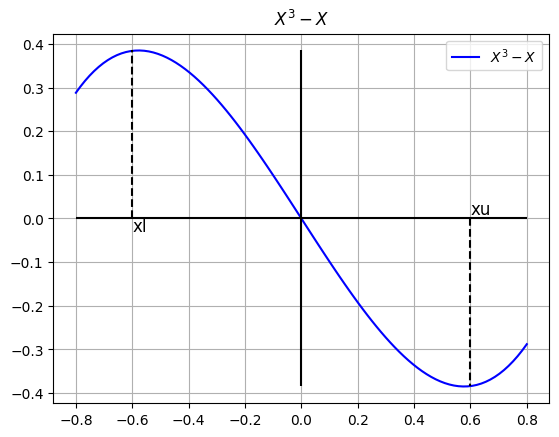
Consiste en hallar una raíz aproximada de una función en un intervalo dado.
Tiende a ser menos eficiente por ser más lento, debido a la cantidad de iteraciones que se requieren para lograr un resultado(convergencia).
Consiste en subdividir el intervalo en otros 2 iguales y evaluar la función con el objetivo de ubicar en donde se hace el cambio de signo, y se sigue repitiendo hasta encontrar la raíz.
Algoritmo para la bisección#
Encontrar un intervalo en donde $\(f(x1)*f(xu)<0\)$.
Se haya una raíz aproximada: $\(xr = \frac{xl+xu}{2}\)$
Encontrar el subintervalo en donde cae la raíz de la siguiente forma:
Si $\(f(xl)*f(xr) < 0\)\( la raíz está entre el intervalo \)xl\( y \)xr\(. Por tal razón, \)xu=xr$ y retorno al paso 2.
Si $\(f(xl)*f(xr) > 0\)\( la raíz está entre el intervalo \)xr\( y \)xu\(. Por tal razón, \)xl=xr$ y retorno al paso 2.
Si $\(f(xl)*f(xr) = 0\)\( la raíz es \)xr$ y termina el cálculo
Cálculo del error relativo#
Tolerancia#
Es qué tan aproximada será la raíz
Ejemplo#
Calcular la raíz de \(f(x)=x^{3}-x\) en el intervalo (0.2, 1.7) con una tolerancia de 1%
Solución#
import numpy as np
import sympy as sp
import matplotlib.pyplot as plt
# Tomamos el intérvalo inicial y grafiquemos la función dentro de ese valor
x = sp.symbols('x')
y = x**3 - x
print("La función es: ",y)
xl,xu = (0.2,1.7)
print(f"El intervalo es: ({xl},{xu}) ")
fxl, fxu = (round(y.subs({x: xl}), 4), round(y.subs({x: xu}), 4))
print(f"la función evaluada en xl y xu respectivamente : (f({xl})={fxl}, f({xu})={fxu}) ")
La función es: x**3 - x
El intervalo es: (0.2,1.7)
la función evaluada en xl y xu respectivamente : (f(0.2)=-0.1920, f(1.7)=3.2130)
# @title Gráfica incial de la función en el rango especificado
import numpy as np
plt.figure()
r = np.linspace(0.1,2, 100)
fx = [y.subs({x:xi}) for xi in r]
fig, ax = plt.subplots()
ax.plot(r,fx,color='blue',label="$X^3 - X$")
## Plano cartesiano (Ejes)
ax.vlines(x=0,ymin=min(fx)-0.5,ymax=max(fx)+0.5,color='k')
ax.hlines(y=0,xmin=min(r)-0.5,xmax=max(r)+0.5,color='k')
## Límites xl y xu
ax.vlines(x=xl, ymin=0, ymax=fxl, color='k', linestyle='--')
ax.vlines(x=xu, ymin=0, ymax=fxu, color='k', linestyle='--')
## Texto de xl y xu
ax.text(xl-0.02, 0.05, f'$x_l={xl}$', fontsize=11, color='black')
ax.text(xu+0.02, 0.05, f'$x_u={xu}$', fontsize=11, color='black')
ax.set_title("$X^3-X$")
ax.grid()
ax.legend()
plt.show()
<Figure size 640x480 with 0 Axes>
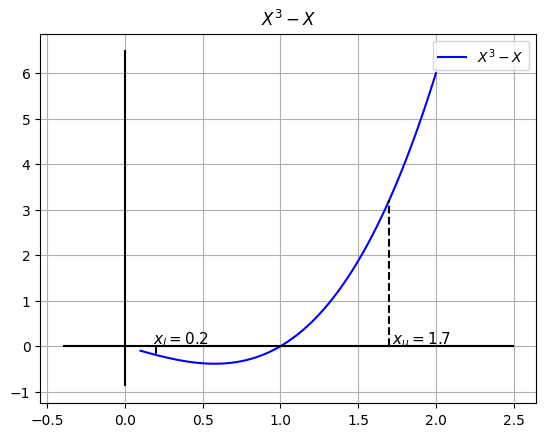
Calculemos ahora la raíz supuesta…#
xr = (xl + xu)/2
fxr = round(y.subs({x:xr}),4)
print(" xr = {:.4f}, f(xr) = {:.4f}".format(xr,fxr))
xr = 0.9500, f(xr) = -0.0926
# @title Gráfica incial con el punto de $x_r$
import numpy as np
plt.figure()
r = np.linspace(0.1,2, 100)
fx = [y.subs({x:xi}) for xi in r]
fig, ax = plt.subplots()
ax.plot(r,fx,color='blue',label="$X^3 - X$")
## Plano cartesiano (Ejes)
ax.vlines(x=0,ymin=min(fx)-0.5,ymax=max(fx)+0.5,color='k')
ax.hlines(y=0,xmin=min(r)-0.5,xmax=max(r)+0.5,color='k')
## Límites xl y xu
ax.vlines(x=xl, ymin=0, ymax=fxl, color='k', linestyle='--')
ax.vlines(x=xu, ymin=0, ymax=fxu, color='k', linestyle='--')
## Texto de xl y xu
ax.text(xl-0.02, 0.05, f'$x_l={xl}$', fontsize=11, color='black')
ax.text(xu+0.02, 0.05, f'$x_u={xu}$', fontsize=11, color='black')
## Pintamos el punto intermedio
ax.plot(xr,fxr,color='red',label='Raíz',marker='o')
ax.text(xr,fxr-0.18, f'$x_r={xr}$', fontsize=11, color='black')
ax.set_title("$X^3-X$")
ax.grid()
ax.legend()
plt.show()
<Figure size 640x480 with 0 Axes>
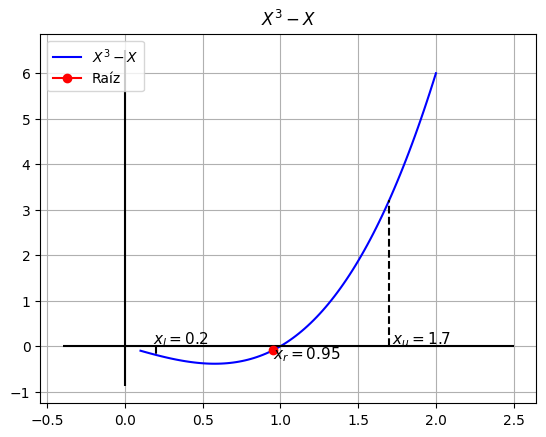
Calculemos el error…#
Como es la primer iteración, NO tendremos forma de calcular un error ya que no existe un \(xr\) anterior. Para las siguientes iteraciones si vamos a calcular el error tomando la siguiente formula.
OJO: Solo para la primer iteración se define arbitrariamente
# @title Tabla de iteraciones
import pandas as pd
columnas = ['Xl','Xu','Xr','er(%)','f(Xl)','f(Xu)','f(Xr)']
primer_iter = {'Xl':[xl],'Xu':[xu],'Xr':[xr],'er(%)':[0],'f(Xl)':[fxl],'f(Xu)':[fxu],'f(Xr)':[fxr]}
tabla = pd.DataFrame(data=primer_iter,columns=columnas)
tabla.head(1)
| Xl | Xu | Xr | er(%) | f(Xl) | f(Xu) | f(Xr) | |
|---|---|---|---|---|---|---|---|
| 0 | 0.2 | 1.7 | 0.95 | 0 | -0.1920 | 3.2130 | -0.0926 |
Revisemos las condiciones#
Si $\(f(xl)*f(xr) < 0\)$ la raíz está entre el intervalo xl y xr. Por tal razón, xu=xr y retorno al paso 2.
Si $\(f(xl)*f(xr) > 0\)$ la raíz está entre el intervalo xr y xu. Por tal razón, xl=xr y retorno al paso 2.
Si $\(f(xl)*f(xr) = 0\)$ la raíz es xr y termina el cálculo
if (fxl * fxr) < 0:
print("La raíz está entre el intervalo xl y xr")
xu = xr
elif (fxl*fxr) > 0:
print("La raíz está entre el intervalo xr y xu")
xl = xr
elif (fxl*fxr) == 0:
print("terminé")
La raíz está entre el intervalo xr y xu
Repetimos los pasos anteriores para calcular el nuevo Xr y el error#
fxl= round(y.subs({x:xl}),4)
fxu= round(y.subs({x:xu}),4)
xr2 = (xl + xu)/2
fxr2 = round(y.subs({x:xr2}),4)
print(" xr = {:.4f}, f(xr) = {:.4f}".format(xr2,fxr2))
error = round(np.abs((xr2-xr)/(xr2))*100,4)
print("El error de este cálculo es: {:.4f}% ".format(error))
xr = 1.3250, f(xr) = 1.0012
El error de este cálculo es: 28.3019%
# @title Gráfica del método para la iteración 2
import numpy as np
plt.figure()
r = np.linspace(0.1,2, 100)
fx = [y.subs({x:xi}) for xi in r]
fig, ax = plt.subplots()
ax.plot(r,fx,color='blue',label="$X^3 - X$")
## Plano cartesiano (Ejes)
ax.vlines(x=0,ymin=min(fx)-0.5,ymax=max(fx)+0.5,color='k')
ax.hlines(y=0,xmin=min(r)-0.5,xmax=max(r)+0.5,color='k')
## Límites xl y xu
ax.vlines(x=xl, ymin=0, ymax=fxl, color='k', linestyle='--')
ax.vlines(x=xu, ymin=0, ymax=fxu, color='k', linestyle='--')
## Texto de xl y xu
ax.text(xl-0.02, 0.05, f'$x_l={xl}$', fontsize=11, color='black')
ax.text(xu+0.02, 0.05, f'$x_u={xu}$', fontsize=11, color='black')
## Pintamos el punto intermedio
ax.plot(xr2,fxr2,color='red',label='Raíz',marker='o')
ax.text(xr2,fxr2-0.18, f'$x_r={xr2}$', fontsize=11, color='black')
ax.set_title("$X^3-X$")
ax.grid()
ax.legend()
plt.show()
<Figure size 640x480 with 0 Axes>
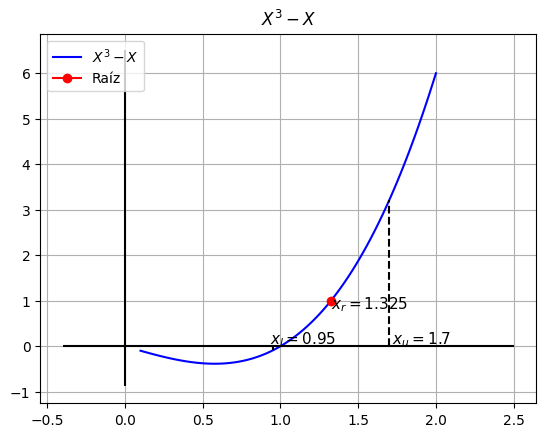
# @title Actualizamos la tabla de iteraciones
nueva_fila = {'Xl': xl, 'Xu': xu, 'Xr': xr2, 'er(%)': error, 'f(Xl)': fxl, 'f(Xu)': fxu, 'f(Xr)':fxr2}
tabla = tabla.append(nueva_fila, ignore_index=True)
tabla.head()
<ipython-input-12-912f58af88d4>:3: FutureWarning: The frame.append method is deprecated and will be removed from pandas in a future version. Use pandas.concat instead.
tabla = tabla.append(nueva_fila, ignore_index=True)
| Xl | Xu | Xr | er(%) | f(Xl) | f(Xu) | f(Xr) | |
|---|---|---|---|---|---|---|---|
| 0 | 0.20 | 1.7 | 0.950 | 0.0000 | -0.1920 | 3.2130 | -0.0926 |
| 1 | 0.95 | 1.7 | 1.325 | 28.3019 | -0.0926 | 3.2130 | 1.0012 |
# @title iteremos hasta que el error sea de 1%
from IPython.display import HTML, display, clear_output
import matplotlib.pyplot as plt
import matplotlib.animation as animation
##############
x = sp.symbols('x')
y = x**3 - x
print("La función es: ",y)
xl,xu = (0.2,1.7)
##############
tol = 1
xr = None
xr_ant = xu
error = tol+1
it = 1
columnas = ['Xl','Xu','Xr','er(%)','f(Xl)','f(Xu)','f(Xr)']
tabla = pd.DataFrame(columns=columnas)
ims = []
while error > tol:
#Evaluamos la función en los puntos del intervalo.
fxl= round(y.subs({x:xl}),4)
fxu= round(y.subs({x:xu}),4)
##################
plt.figure()
fig, ax = plt.subplots()
r = np.linspace(0.1,2, 100)
fx = [y.subs({x:xi}) for xi in r]
ax.plot(r,fx,color='blue',label="$X^3 - X$")
## Plano cartesiano (Ejes)
ax.vlines(x=0,ymin=round(min(fx),4)-0.5,ymax=round(max(fx),4)+0.5,color='k')
ax.hlines(y=0,xmin=round(min(r),4)-0.5,xmax=round(max(r),4)+0.5,color='k')
ax.set_title("$X^3-X$")
ax.grid()
##################
## Límites xl y xu
ax.vlines(x=xl, ymin=0, ymax=fxl, color='k', linestyle='--',label=f'$x_l=${xl}')
ax.vlines(x=xu, ymin=0, ymax=fxu, color='k', linestyle='--',label=f'$x_u=${xu}')
#Calculamos la raíz
xr = round((xl + xu)/2,4)
fxr = round(y.subs({x:xr}),4)
## Pintamos el punto intermedio
ax.plot(xr,fxr,color='red',label=f'$Raíz=${xr}',marker='o')
ax.legend()
plt.show()
error = np.abs((xr-xr_ant)/(xr))*100
nueva_fila = {'Xl': xl, 'Xu': xu, 'Xr': xr, 'er(%)': error, 'f(Xl)': fxl, 'f(Xu)': fxu, 'f(Xr)':fxr}
nueva_fila = pd.DataFrame([nueva_fila])
tabla = pd.concat([tabla, nueva_fila], ignore_index=True)
display(HTML(tabla.head(it).to_html()))
if (fxl * fxr) < 0:
xu = xr
elif (fxl*fxr) > 0:
xl = xr
elif (fxl*fxr) == 0:
print(f"La raiz está en: ({xr},{fxr})")
break
xr_ant = xr
it+=1
print("")
input()
clear_output(wait=True)
<Figure size 640x480 with 0 Axes>
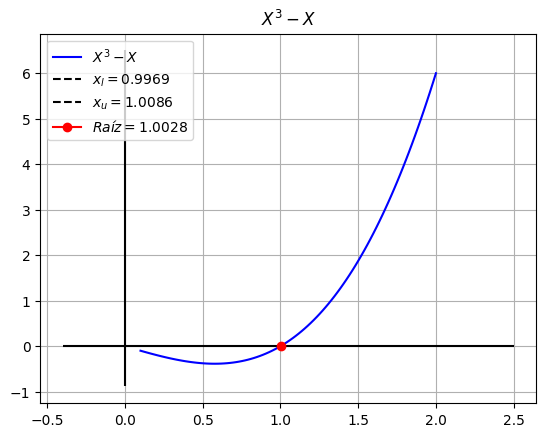
| Xl | Xu | Xr | er(%) | f(Xl) | f(Xu) | f(Xr) | |
|---|---|---|---|---|---|---|---|
| 0 | 0.2000 | 1.7000 | 0.9500 | 78.947368 | -0.1920 | 3.2130 | -0.0926 |
| 1 | 0.9500 | 1.7000 | 1.3250 | 28.301887 | -0.0926 | 3.2130 | 1.0012 |
| 2 | 0.9500 | 1.3250 | 1.1375 | 16.483516 | -0.0926 | 1.0012 | 0.3343 |
| 3 | 0.9500 | 1.1375 | 1.0437 | 8.987257 | -0.0926 | 0.3343 | 0.0932 |
| 4 | 0.9500 | 1.0437 | 0.9969 | 4.694553 | -0.0926 | 0.0932 | -0.0062 |
| 5 | 0.9969 | 1.0437 | 1.0203 | 2.293443 | -0.0062 | 0.0932 | 0.0418 |
| 6 | 0.9969 | 1.0203 | 1.0086 | 1.160024 | -0.0062 | 0.0418 | 0.0174 |
| 7 | 0.9969 | 1.0086 | 1.0028 | 0.578381 | -0.0062 | 0.0174 | 0.0056 |
# @title Grafico dinámico (movie del método)
# Librerias necesarias para realizar el gráfico
import numpy as np
import matplotlib.pylab as plt
from matplotlib import animation, rc
from IPython.display import HTML;
rc('animation', html='html5');
x = sp.symbols('x')
y = x**3 - x
# Plantilla sobre la cual se realiza el gráfico
r = np.linspace(0.1,2, 100)
fx = [y.subs({x:xi}) for xi in r]
fig, ax = plt.subplots()
ax.plot(r,fx,color='blue',label="$X^3 - X$")
## Plano cartesiano (Ejes)
ax.vlines(x=0,ymin=round(min(fx),4)-0.5,ymax=round(max(fx),4)+0.5,color='k')
ax.hlines(y=0,xmin=round(min(r),4)-0.5,xmax=round(max(r),4)+0.5,color='k')
ax.set_title("$X^3-X$")
ax.grid()
# Se definen los atributos que debe tener la linea o en este caso el punto que se va a pintar en cada iteracion
linea, = ax.plot([],[],'o',color = 'r', label = '')
# Realizamos una función que grafique el punto especifico uno a uno
frames = len(tabla);
def graficar(i):
x = tabla['Xr'].to_list()
y = tabla['f(Xr)'].to_list()
linea.set_data(x[i],y[i])
linea.set_label(f"Raíz={x[i]}")
ax.legend()
return (linea,)
plt.close()
# Ejecutamos la animación para que se genere y quede en loop mostrando su resultado.
anim = animation.FuncAnimation(fig, graficar, frames=frames, interval=1000,repeat=False)
anim
<ipython-input-14-745227570119>:37: MatplotlibDeprecationWarning: Setting data with a non sequence type is deprecated since 3.7 and will be remove two minor releases later
linea.set_data(x[i],y[i])
Ejercicio#
Calcular la raíz de \(y = \frac{667,38}{x}(1 - e^{-0,146843x}) - 40\) en el intervalo (12, 16) con una tolerancia de 0.5%
Implementar una función que me permita dinámicamente modificar la tolerancia y el intervalo, además de la gráfica y que me retorne la raíz, el error, la tabla de iteraciones y la gráfica dinámica de como itera el método.
